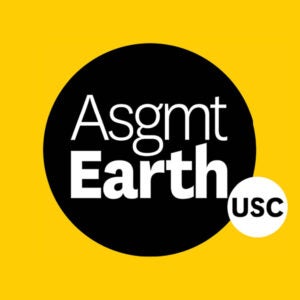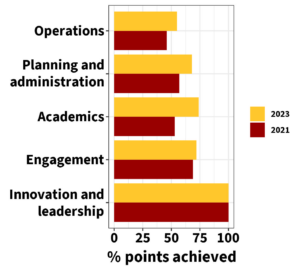USC Earns Gold Rating for Sustainability Initiatives
USC has earned a gold rating from the Association for the Advancement of Sustainability in Higher Education, a professional association for the campus sustainability community.
The achievement comes after significant efforts to create a greener and more sustainable university under USC President Carol Folt’s sustainability “moonshot,” which marshals research, teaching, operations, inclusion and community engagement efforts to create a healthy, just and thriving world.

The rating is based on criteria established by the AASHE’s Sustainability Tracking, Assessment & Rating System (STARS), a comprehensive sustainability benchmarking system for colleges and universities that addresses the environmental, social and economic aspects of sustainability.
“Our Assignment: Earth strategy has always been to make sure sustainability is integrated throughout the university,” said Mick Dalrymple, USC’s chief sustainability officer. “It’s not solely about earning a gold rating, but also about how we continuously improve and how we work together to solve sustainability challenges globally. Everything is connected and everyone plays a role in solutions.”
Measuring sustainable universities
The AASHE STARS program is a self-assessment system in which more than 900 institutions across 40 countries participate. Participants report achievements in five overall areas: academics; engagement; operations; planning and administration; and innovation and leadership. An institution’s STARS score is based on the percentage of applicable points earned in credits across those main categories.

There are five levels of recognition in the STARS program, each with a minimum score. A bronze rating starts at 25, silver at 45, gold at 65 and platinum at 85. Institutions that are just learning STARS can remain unscored and be listed as “reporters.”
Of the 352 institutions with valid STARS ratings, 32 have a bronze rating, 131 reached silver, 157 reached gold and 12 reached platinum. There are also 20 identified as reporters.
“This is quite the achievement,” Dalrymple said. “Students should feel heard and confident that their university is really taking this seriously and is moving very rapidly to spread its sustainability practices throughout the entire university.”
The program is designed to provide a framework for understanding sustainability in all sectors of higher education, as well as to compare institutions using a common set of measurements. According to the AASHE, the STARS rating system creates incentives for continual improvement toward sustainability but is not a competition between institutions — the program helps facilitate information sharing about higher education sustainability practices and performance. The goal is to build a stronger, more diverse campus sustainability community.
“STARS was developed by the campus sustainability community to provide high standards for recognizing campus sustainability efforts,” said Meghan Fay Zahniser, executive director of the AASHE. “USC has demonstrated a substantial commitment to sustainability by achieving a STARS gold rating and is to be congratulated for their efforts.”
Improvements made and the road ahead
USC submitted its data for the first time in 2021, when it received a silver rating with a score of 58.21. Initially, the goal of a gold rating — which requires a score of 65 or higher — was set for 2025. This year’s results put USC ahead of schedule for that goal with a score of 69.91.
“That’s definitely something that should make us proud,” said Mahta Moghaddam, co-chair of the USC Presidential Working Group on Sustainability in Education, Research and Operations. “It shows the institution’s commitment to sustainability and reaching these goals, especially looking at how complex it is to reach them. It gives you a lot of food for thought about how much work has gone into it.”
The biggest improvement came in academics, which is broken down into two categories, curriculum and research. When USC earned a silver rating in 2021, the university scored 20.99 out of 40 points in curriculum and 9.46 out of 18 points in research. This year, USC received 32.65 out of 40 for curriculum and 10.49 out of 18 in research. Part of that was due to an increase in sustainability-related academic courses and the addition of a sustainability literacy survey for incoming and graduating cohorts.
Moghaddam, who is also a Distinguished Professor of Electrical and Computer Engineering at the USC Viterbi School of Engineering, said the next STARS goal within Assignment: Earth is a platinum rating. She said the university has the leadership — and more importantly the student population — to achieve a score of 85 by 2028.
“We exist because of our students, and they are very much impact-oriented and impact-conscious these days,” Moghaddam said. “Sustainability is among the top concerns that they have. Achieving the gold rating shows that USC is sensitive and committed to what the students care about right now, and it shows that we’re on the right trajectory.”
Dalrymple said the 2028 goal aligns with the 2028 Summer Olympic and Paralympic Games in Los Angeles. Although it’s a lofty goal, considering that less than 4% of institutions that submitted data currently possess a platinum rating, Dalrymple said USC is up to the challenge.
“We still have a long way to go as a university and as a global society,” Dalrymple said. “We haven’t solved the climate crisis; we haven’t solved biodiversity loss or depletion of resources. There’s still a long road to go but considering that USC has come this far in two years, and that our research is helping create solutions and our students are going out into the world as future leaders, I am optimistic that Trojans can lead by example and will contribute to a much brighter future.”

